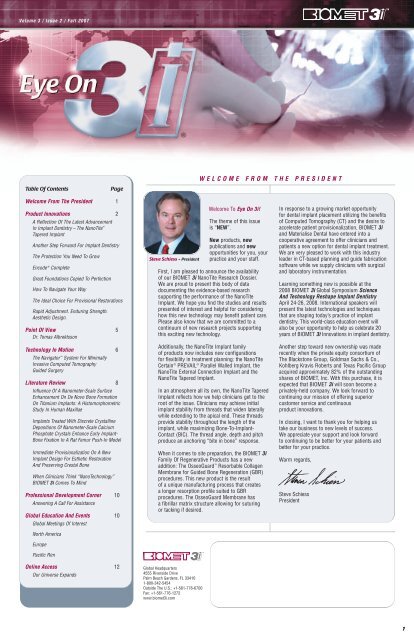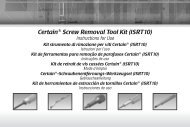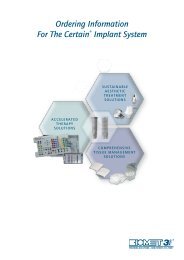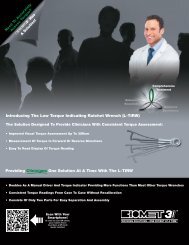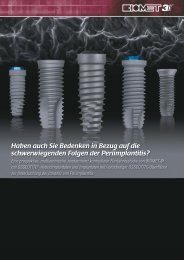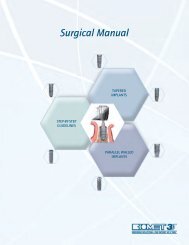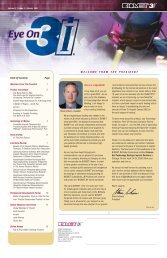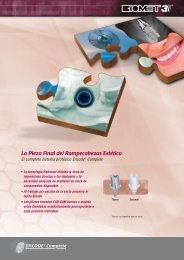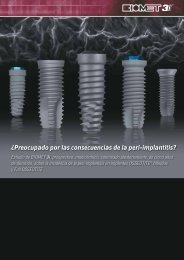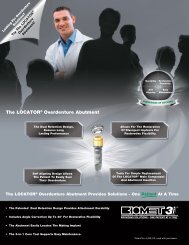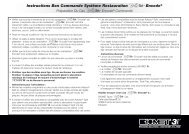Fall 2007 - Biomet 3i
Fall 2007 - Biomet 3i
Fall 2007 - Biomet 3i
You also want an ePaper? Increase the reach of your titles
YUMPU automatically turns print PDFs into web optimized ePapers that Google loves.
Volume 3 / Issue 2 / <strong>Fall</strong> <strong>2007</strong>Table Of ContentsPageW E L C O M E F R O M T H E P R E S I D E N TWelcome From The President 1Product Innovations 2A Reflection Of The Latest AdvancementIn Implant Dentistry–The NanoTite Tapered ImplantAnother Step Forward For Implant DentistryThe Protection You Need To GrowEncode ® CompleteGreat Foundations Copied To PerfectionHow To Navigate Your WayThe Ideal Choice For Provisional RestorationsRapid Adjustment. Enduring Strength.Aesthetic Design.Point Of View 5Dr. Tomas AlbrektssonTechnology In Motion 6The Navigator System For MinimallyInvasive Computed TomographyGuided SurgeryLiterature Review 8Influence Of A Nanometer-Scale SurfaceEnhancement On De Novo Bone FormationOn Titanium Implants: A HistomorphometricStudy In Human MaxillaeImplants Treated With Discrete CrystallineDepositions Of Nanometer-Scale CalciumPhosphate Crystals Enhance Early Implant-Bone Fixation In A Rat Femur Push-In ModelImmediate Provisionalization On A NewImplant Design For Esthetic RestorationAnd Preserving Crestal BoneWhen Clinicians Think “NanoTechnology”BIOMET <strong>3i</strong> Comes To MindProfessional Development Corner 10Answering A Call For AssistanceGlobal Education And Events 10Global Meetings Of InterestNorth AmericaEuropePacific RimOnline Access 12Our Universe ExpandsSteve Schiess - PresidentGlobal Headquarters4555 Riverside DrivePalm Beach Gardens, FL 334101-800-342-5454Outside The U.S.: +1-561-776-6700Fax: +1-561-776-1272www.biomet<strong>3i</strong>.comWelcome To Eye On <strong>3i</strong>!The theme of this issueis “NEW”.New products, newpublications and newopportunities for you, yourpractice and your staff.First, I am pleased to announce the availabilityof our BIOMET <strong>3i</strong> NanoTite Research Dossier.We are proud to present this body of datadocumenting the evidence-based researchsupporting the performance of the NanoTiteImplant. We hope you find the studies and resultspresented of interest and helpful for consideringhow this new technology may benefit patient care.Please also know that we are committed to acontinuum of new research projects supportingthis exciting new technology.Additionally, the NanoTite Implant familyof products now includes new configurationsfor flexibility in treatment planning: the NanoTiteCertain ® PREVAIL ® Parallel Walled Implant, theNanoTite External Connection Implant and theNanoTite Tapered Implant.In an atmosphere all its own, the NanoTite TaperedImplant reflects how we help clinicians get to theroot of the issue. Clinicians may achieve initialimplant stability from threads that widen laterallywhile extending to the apical end. These threadsprovide stability throughout the length of theimplant, while maximizing Bone-To-Implant-Contact (BIC). The thread angle, depth and pitchproduce an anchoring “bite in bone” response.When it comes to site preparation, the BIOMET <strong>3i</strong>Family Of Regenerative Products has a newaddition: The OsseoGuard Resorbable CollagenMembrane for Guided Bone Regeneration (GBR)procedures. This new product is the resultof a unique manufacturing process that createsa longer resorption profile suited to GBRprocedures. The OsseoGuard Membrane hasa fibrillar matrix structure allowing for suturingor tacking if desired.In response to a growing market opportunityfor dental implant placement utilizing the benefitsof Computed Tomography (CT) and the desire toaccelerate patient provisionalization, BIOMET <strong>3i</strong>and Materialise Dental have entered into acooperative agreement to offer clinicians andpatients a new option for dental implant treatment.We are very pleased to work with this industryleader in CT-based planning and guide fabricationsoftware while we supply clinicians with surgicaland laboratory instrumentation.Learning something new is possible at the2008 BIOMET <strong>3i</strong> Global Symposium ScienceAnd Technology Reshape Implant DentistryApril 24-26, 2008. International speakers willpresent the latest technologies and techniquesthat are shaping today’s practice of implantdentistry. This world-class education event willalso be your opportunity to help us celebrate 20years of BIOMET <strong>3i</strong> Innovations in implant dentistry.Another step toward new ownership was maderecently when the private equity consortium ofThe Blackstone Group, Goldman Sachs & Co.,Kohlberg Kravis Roberts and Texas Pacific Groupacquired approximately 82% of the outstandingshares of BIOMET, Inc. With this purchase, it isexpected that BIOMET <strong>3i</strong> will soon become aprivately-held company. We look forward tocontinuing our mission of offering superiorcustomer service and continuousproduct innovations.In closing, I want to thank you for helping ustake our business to new levels of success.We appreciate your support and look forwardto continuing to be better for your patients andbetter for your practice.Warm regards,Steve SchiessPresident1
P R O D U C T I N N O V A T I O N SA Reflection Of The Latest Advancement In Implant Dentistry –The NanoTite Tapered ImplantIn an atmosphere all its own, the NanoTiteTapered Implant reflects how BIOMET <strong>3i</strong> hascombined the forces of implant dentistryand nanotechnology to launch a newaddition to our NanoTite ImplantFamily Of Products.Designed for optimal performance,the NanoTite Tapered Implant offers:Next Generation Surface Technology –The NanoTite Implant builds on the successof the OSSEOTITE ® Surface by creating a morecomplex surface topography rendering theimplant a Bone Bonding Surface by theinterlocking of the newly formed cementline matrix of bone with the implant surface.A True Tapered Shape – approximates the shape of a naturaltooth root, making it useful when only a tapered shape will do.Innovative Thread Design – threads widen laterally whileextending to the apical end, providing stability throughoutthe length of the implant, while maximizing Bone-To-Implant-Contact (BIC). The thread angle, depth and pitchproduce an anchoring “bite in bone” response.Domed Apical End – desirable in areas where implantplacement approximates vital structures like the alveolarnerve or sinus membrane.Ease Of Insertion With Spiral IncrementalCutting Edge – progressive cutting edges, in a helicalpattern with trailing thread relief for ease of insertion;cupped recesses act as repositories for boneshavings, blood and growth factors, potentiallyoffering a “head start” to osseointegration.QuickSeat ® Connection and External Connectionconfigurations for clinician preference. Fourdiameters and five lengths offer surgicalflexibility.Put Order In Your Universe –Our Tapered Implant SurgicalInstrumentation provides options thatfacilitate effective treatment planning.Every element of the NanoTite TaperedImplant System—surgical tray, QuadShaping Drills (QSDs), Depth/DirectionIndicators (NTDIs), Dense Bone Tapsand implants—is color-coded foreasy identification.When placing the NanoTite Tapered Implant, theneed to tap the osteotomy may arise, especially indense bone, so BIOMET <strong>3i</strong> has developed the newDense Bone Tap Kit. A specific tap matches eachNanoTite Tapered Implant to aid in length specificfinal implant placement. Thread angle and crest widthof the taps correspond with the implant and these areanodized (color-coded) for accurate identification.Enter a new world in dental implant technology bycalling your BIOMET <strong>3i</strong> Sales Representative today.NanoTite Tapered Implant Surgical KitSurgical And Restorative Flexibility – convenientlycolor-coded to correspond with full-length taps forease of placement; available in the Certain ®Dense Bone Tap KitAnother Step Forward For Implant DentistryIn addition to the NanoTite TaperedImplant, clinicians may choose fromthese configurations for flexibility intreatment planning:NanoTiteCertain ® PREVAIL ®Parallel WalledImplantNanoTiteCertainImplantNanoTiteExternalConnectionImplant• The NanoTite Certain PREVAILParallel Walled Implant, whichincorporates integrated PlatformSwitching and has the OSSEOTITESurface and the nano-scale crystalsto the top of the collar creating acontinuous bone-loading surface• The NanoTite Certain Implant, amodified hybrid where the coverageof both the OSSEOTITE Surface andthe nano-scale crystals go up to thebase of the implant collar• The NanoTite External ConnectionImplant, also featuring theOSSEOTITE Surface and thenano-scale crystals up to thebase of the implant collarFor flexibility in treatment planning,call your BIOMET <strong>3i</strong> SalesRepresentative today.2
P R O D U C T I N N O V A T I O N S C O N T I N U E DThe Protection You Need To GrowEncode ® CompleteThe new OsseoGuard Resorbable CollagenMembrane is designed to give the protectionneeded to help patients grow bone during GuidedBone Regeneration (GBR) procedures. Cliniciansmay find it a new option due to severalcharacteristics:• Unique Manufacturing Process CreatesA Longer Resorption Profile Suited ToGBR Procedures• Fibrillar Matrix Structure Provides StrengthFor Tacking Or Suturing If Desired• Double Sterile Packaging For AddedPatient Safety• Excellent Handling Characteristics WhenHydrated—Adaptable To Various Defects• Pure Bovine Type I Achilles TendonCollagen Sourced From Closed HerdsFor Increased SecurityThe OsseoGuardMembrane allows for the passage of beneficialfluids and nutrients, yet it remains occlusive togingival and epithelial cells. The membranedoes not require side-specific placement, hasa shelf-life of three years and is designed forGBR indications such as:• Localized Ridge Augmentation/FutureImplant Site Preparation• Periimplant Bone Defects Around Implants• Extraction Sockets• Bone Regeneration After Root Resection• Sinus WindowFor the protection you need to grow, call yourBIOMET <strong>3i</strong> Sales Representative today.Distributed by BIOMET <strong>3i</strong>. Manufactured byCollagen Matrix, Inc., Franklin Lakes, NJClinicians spoke, welistened. BIOMET <strong>3i</strong> is inthe process of modifyingthe Encode RestorativeSystem to offer cliniciansthe simplicity they needwith the aesthetics they want. With “EncodeComplete” featuring Robocast Technology,BIOMET <strong>3i</strong> will manufacture patient specificabutments and fabricate a master cast withimplant analogs by using a closed-trayimpression of Encode Healing Abutments,CAD/CAM technology and robotics.With one closed tray impression, clinicianscan go to the final restoration. This meansfewer steps, fewer components and minimaltissue disturbance.Full commercial release of this technologyin the U.S. is expected by early 2008.Great Foundations Copied To PerfectionBIOMET <strong>3i</strong> continues to expand technological capability for itsfabrication of CAM StructSURE ® Precision Milled Bars to includecopymilling a resin pattern.*For a list of participating ARCHITECH PSR ® Laboratories and more aboutCAM StructSURE Precision Milled Bars, visit www.biomet<strong>3i</strong>.com or callyour local BIOMET <strong>3i</strong> Sales Representative today.Laboratory technicians can now create their own unique bar designwith a resin pattern and send it to BIOMET <strong>3i</strong> to be scanned and milledwith a master cast. Using a copymilling technique, BIOMET <strong>3i</strong> createsa one-piece, titanium alloy replica of the design to fit the master castand returns it to the laboratory.In addition, BIOMET <strong>3i</strong> continues to offer virtual design and millingof bars for laboratory technicians who wish to minimize their labor whenfabricating overdenture and fixed-hybrid restorations. CAM StructSUREPrecision Milled Bars—the foundations for great restorations.* Commercially available <strong>Fall</strong> <strong>2007</strong>Please Note: Not all products are available outside the U.S. Please contact your local BIOMET <strong>3i</strong> Sales Representative for availability.3
P R O D U C T I N N O V A T I O N S C O N T I N U E DHow To Navigate Your WayThe Ideal Choice ForProvisional RestorationsIf you are a clinician whoprefers screw-retaineddefinitive restorations butwants the simplicity andcost effectiveness ofcement-retained immediateor delayed provisionalbridges, QuickBridge Provisional RestorationComponents* may bean ideal choice.When you want to chart new territory, lookto BIOMET <strong>3i</strong> for the latest in CT GuidanceTechnology.We developed the Navigator System* for CTGuided Surgery in response to clinicians’ growinginterest in dental implant placement utilizing thebenefits of Computed Tomography (CT) and thedesire to accelerate patient provisionalization.By using the BIOMET <strong>3i</strong> Navigator System, inconjunction with planning software and surgicalguides, clinicians will be able to enhancetreatment planning and improve the accuracyof placing BIOMET <strong>3i</strong> Implants. The system willbe open architecture, compatible with leadingplanning software.CT guidance technology allows cliniciansto measure more precisely the locationsof anatomical structures and the dimensionsof underlying bone as well as to ascertain bonedensities in order to plan and perform cases. Useof CT scans allows procedures to be substantiallyless invasive than traditional surgery. The addedprecision can shorten chair time for full-arch,single-tooth and short-span implant cases,allowing for more efficient procedures.The Navigator System can be used with asurgical guide stent to fabricate a provisionalprosthesis prior to implant placement. Thesystem allows clinicians to place dental implantsin predetermined locations with proper hexorientation. It offers clinicians the option todeliver a prosthesis the day of surgery and theopportunity to perform bone, teeth and tissuesupported (flapless) surgery.BIOMET <strong>3i</strong>’s Navigator System includes theNavigator Surgical Kit and the NavigatorLaboratory Kit.For your guide to precision implant dentistry, callyour BIOMET <strong>3i</strong> Sales Representative today.QuickBridge Provisional RestorationComponents offer you an easy way tofabricate provisional, multi-unit, cementretainedimplant restorations on ConicalAbutments. There are only two components:A titanium cylinder that threads onto theStraight or Angled Conical Abutment interfaceand a cap that snaps onto the collar of thecylinder. The cap is either preprocessed intothe provisional restoration in the laboratoryor picked up inside the prefabricated orchairside-fabricated provisional restoration.The provisional bridge is then temporarilycemented onto the titanium cylinders andmay stay in place up to 180 days.When the patient is ready for the definitiveimpressions and restoration, the provisionalbridge and cylinders are removed and thedefinitive restoration is seated on the sameConical Abutments, saving additional cost foryou and your patient. QuickBridge ProvisionalComponents will be commercially available in<strong>Fall</strong> <strong>2007</strong>.For more information, call your BIOMET <strong>3i</strong>Sales Representative today.* Commercially available <strong>Fall</strong> <strong>2007</strong> * 510(k) and CE Mark pendingRapid Adjustment. Enduring Strength. Aesthetic Design.For rapid adjustments to winning smiles, PreFormance ® ProvisionalComponents offer new options for “PEEK” performance. For morenatural aesthetics, BIOMET <strong>3i</strong> has added a 6mm Emergence Profile (EP ® )to the PreFormance Post 4.1mm platform for both the PreFormancePost and Pre-Angled PreFormance Post. The PreFormance Post EP isa feature that allows for the final restoration’s natural emergence throughthe soft tissue.Made of a strong, biocompatible material called PEEK (polyetheretherketone),the PreFormance Post is easily customized to yourpatient’s tissue contours and anatomic profile. Intraoral preparationtime is faster and easier than with titanium and patients can leavewith pleasing aesthetics the day of surgery.As a cost-effective option for optimum tissue healing, PreFormanceProvisional Components offer some of the longest in vivo use of polymerson the market—180 days versus 30 days.For high performancewith immediateresults, call yourBIOMET <strong>3i</strong> SalesRepresentative today.Please Note: Not all products are available outside the U.S. Please contact your local BIOMET <strong>3i</strong> Sales Representative for availability.4
P O I N T O F V I E WDr. Tomas AlbrektssonShares His Thoughts OnImplant Materials DuringA Recent ConversationWith Lars Janson, VicePresident Of InternationalOperations, BIOMET <strong>3i</strong>.Thank you for taking time out of your busyschedule to talk with us today. On behalf of allof the BIOMET <strong>3i</strong> Employees worldwide, wewant to congratulate you again for your recentreceipt of the Academy of OsseointegrationLifetime Achievement Award. This is asignificant acknowledgement of your scientificleadership in the field of implant dentistry.Göteborg University has been at the forefrontof studying implant surfaces for many years.Where do you see the industry going in termsof next generation surface technologies?There are three predominant areas of implantsurface research that we are aware of andinvolved with here at Göteborg Biomaterials.The first is the incorporation of nano features.BIOMET <strong>3i</strong>’s new implant surface falls into thiscategory. The in vitro, pre-clinical and humanhistology data* on improved Bone-To-Implant-Contact (BIC) look very promising. The secondis chemical bonding. Although this approachis interesting, I think it will be difficult to proveboth experimentally and clinically. The third isthe use of additives that stimulate bone growth.Our experimental results have so far beendisappointing but these surfaces may proveto be helpful in rare, unstable cases.You recently participated in an importantsymposium in Göteborg on new implantsurfaces where an important update wasprovided on BIOMET <strong>3i</strong>’s new NanoTite Implant. Are there some observations orconclusions you can share from theinformation that was presented?The multiple experimental studies presentedshow a much stronger bone response vs. theappropriate controls. We remain hopeful thatthese data will transfer to the clinical experience.I was able to review some preliminary clinicaldata at a recent conference in Göteborg andI will await publication of these resultswith interest.The mechanism of action for a NanoTiteImplant is thought to be the combined effectof the biologic benefits of CaP and thenanotopography of the surface. Based onyour cumulative experience in the field,do you have a particular theory?* 510(k) pendingI would tend to agree with the theory ofnanotopography. I do not fear the HA aspectof a NanoTite Implant due to the nano rangesize of these particles. Calcium phosphates havealways been promising and the design of theNanoTite Implant addresses the one importantdownside of large particles flaking off.Forty years ago, the concept of osseointegrationwas born based on the use of commerciallypure titanium implants. Today, the useof titanium alloy is becoming morewidespread due its predominant use inorthopedics and improved strength. What areyour thoughts on the use of titanium alloy asan implant material?It is true that our group had some initialconcerns about the use of alloys. Theexperimental results that we conducted earlyon indicated a slightly weaker bone responsecompared to that of commercially pure titanium,but this potential drawback has not been at allverified in clinical reality. There are more thanfive years of documented clinical results thatdemonstrate good success with titanium alloysin oral implantology and the alloy is frequentlyused in orthopedics with good results. There isno evidence of any kind of the negative effectof aluminum and vanadium leakage like wepreviously feared. We have changed our mindson this topic and it is important that thismessage reaches the global implant community.Zirconia implants are now being marketedby some companies. Are you aware of anyclinical data on the reliability of zirconia asa dental implant material?I will remain skeptical about the use of zirconiain the anchoring portion of a dental implant untilwe have seen positive clinical documentation ofthis ceramic. I am aware of only one publishedstudy in the German implant journal which wasfar from convincing. Our department is notinvestigating this type of implant material foranchoring portions at this time. However, wedo use zirconia as a gliding surface in our hipmodels as well as recognize that it can be usedin abutments.You have recently communicated the need formore pre-commercialization research fromindustry prior to the launch of new implantdesigns. Please comment on this further.It is important that our position on this subject iswell understood. We do not believe there is aneed for extensive clinical trials on every singleimplant design change. The amount of researchconducted on several new implant surfaces toinclude the NanoTite Implant Surface, wasappropriate. However, there are several designchanges that do require extensive research.The use of rough surfaces in soft tissues requireextensive data prior to commercialization. Inaddition, we must be very aware of what I liketo call the “biologic challenge”; in biology, 1+1+1makes 9, not 3. Information from studiesinvestigating one aspect of implant placementcannot automatically be combined with datafrom other studies investigating other aspects.This is one example of when the dental implantindustry needs to be careful and not drawconclusions which are too simple.BIOMET <strong>3i</strong> is currently working on variousrecent initiatives with Göteborg Universityas part of a comprehensive Research andEducation Collaboration Agreement. Pleasecomment on your perspective regardingthis relationship.The University must be open to having a strongrelationship with the dental implant industry.I admire BIOMET <strong>3i</strong>’s approach of sharing allof the information available and using a varietyof study designs to arrive at the practicalbenefits of their technology. We are delightedto have BIOMET <strong>3i</strong> involved with many of ourdepartments through a variety of interestingprojects. We look forward to bringing thesestudy results to the dental implant communityin the future.Tomas Albrektsson, MD, PhD, ODhc (Sweden)has been a Professor and Head of Departmentof Handicap Research (Dept. of Biomaterials), forthe University of Göteborg since 1986. He has alsobeen Chairman of the Department since 1988, whichis today a part of the department of Clinical Sciences,with the Sahlgrenska Academy at Göteborg University.Dr. Albrektsson holds several patents in the field ofbiomaterials and is also the author of some 600abstracts, reviews and scientific papers on bonegrafts, vital microscopy of bone, experimentalimplants, oral and craniofacial reconstructions andorthopedic implants.5
T E C H N O L O G Y I N M O T I O NThe Navigator System For Minimally Invasive Computed Tomography Guided SurgeryImmediate Provisionalization Of A Two-UnitRestoration In The Posterior Mandible:A Case Presentation† Michael Block, DMD‡ Marco Brindis, DDS+ Paulino Castellon, DDSFigure 1Figure 2Figure 3Figure 4Figure 5Figure 7Figure 8Figure 9Figure 10Figure 11CT (Computed Tomography) guided dental implantplacement has been introduced due to an elevatedinterest by clinicians to perform minimally invasiveimplant placement protocols thus reducing post-operativemorbidity and to provide patients with same dayrestorative solutions. In clinical situations where thereis limited bone height above the inferior alveolar canalor under the maxillary sinus, the accuracy by whichimplant placement can be performed with CT guidedimplant placement is a valuable tool. Additionally, theinformation derived from the CT scan affords theopportunity to fabricate a working cast with implantanalogs using the surgical guide. The position of theanalogs in the cast matches the predetermined implantpositions planned in the software. On this working cast,a laboratory processed provisional restoration can beprefabricated for immediate placement at the time ofimplant placement with minimal chairside adjustment.The Clinical Case Presentation to follow demonstratesa 58-year-old male patient who presented with anon-restorable mandibular left second premolar and firstmolar secondary to caries and fracture. The patientrequested treatment which would “minimize my timewithout teeth in this area, and avoid swelling and painwhich might keep me from my employment.” To realizethe patient’s goals, the teeth were extracted and thesockets were grafted with mineralized bone in anticipationof implant placement (Figure 1). Three months later,clinical examination revealed adequate ridge width andheight for implant placement. A CT scan was obtained,reformatted with virtual implants placed and a surgicalguide was fabricated. One month later, with theassistance of CT guided dental implant placement, twoimplants were placed and immediately provisionalizedwith a fixed, non-occlusally loaded provisionalrestoration. The patient was able to return to work thenext day without discomfort or swelling.TreatmentA sulcular incision was made with anterior and posteriorvertical release. Teeth #’s 19 and 20 were removedusing sectioning techniques because of ankylosisof the teeth to the bone. The buccal bone was preserved.Approximately 1cc of University of Miami Tissue Bankmineralized allograft bone (300-500 micron diameter)was placed into the sites, which was primarily coveredby advancing the buccal tissue.CT Scanning And PlanningThree months post tooth extraction and grafting(Figure 2), a CT scan was obtained with 1mm thickaxial sections and the occlusal plane at a 0 gantry angle,following the radiographic protocol of Materialise Dental,Inc. (Glen Burnie, MD). The DICOM data was placed ona CD, which was then processed using SimPlant ProInteractive CT Planning Software from Materialise.The inferior alveolar nerve was labeled on the CT scan(Figures 3 & 4). Two virtual implants were placed intothe reformatted images. The relationship of the plannedimplants to the nerve and cortical bone can be seen inFigure 5. A mandibular cast was sent to Materialise tofacilitate fabrication of a tooth borne surgical guide(Figures 6 and 7).Figure 6Figure 126
T E C H N O L O G Y I N M O T I O N C O N T I N U E DFabrication Of A Provisional RestorationThe appropriate diameter and length analog mounts wereselected from the Navigator Laboratory Kit. Two holeswere created in the master cast to accept the implantlaboratory analogs (Figure 8). The appropriate sized analogmounts were inserted into the master tubes. The analogswere attached and the rotational positioning grooves wereengaged with each analog mount to establish the properalignment of the hexes from the cast to the mouth. Thethumb screws on the analog mounts were tightened into theanalogs (Figure 9). The analogs were secured with stone tothe cast using the surgical guide to accurately position theanalogs. After the stone hardened, the thumb screws of theanalog mounts were loosened and the surgical guide wasremoved leaving the analogs in the cast (Figure10).PreFormance ® Posts consistent with the restorative seatingplatforms of the implants, were selected for use as interimabutments. The provisional abutments were placed into theanalogs in the cast (Figure 11). These were prepared onlyto locate the margins in the desired location (Figure 12).A two-unit fixed acrylic provisional restoration was thenfabricated without occlusal contacts (Figures 13 and 14).† Professor Department of Oral and Maxillofacial Surgery, Louisiana State University, School of Dentistry, New Orleans, LA‡ Senior Resident Department of Prosthodontics, Louisiana State University, School of Dentistry, New Orleans, LA+ Associate Professor Department of Prosthodontics, Louisiana State University, School of Dentistry, New Orleans, LAFigure 13Figure 19Implant Placement And ProvisionalizationThe keratinized gingiva on the crest was bisected and alimited periosteal reflection was made. Small vertical releaseincisions were made anteriorly and posteriorly, allowing afull thickness flap to be reflected to the buccal and lingualcrests. The flap was made to insure that the keratinizedgingiva would surround the implant abutments. A tissuepunch would have eliminated the 4mm wide band ofkeratinized gingiva.The surgical guide was placed over the teeth (Figure 15).It was stable and without movement. The Drill PositioningHandles and twist drills (Figure 16) were selected fromthe Navigator Surgical Kit using the drill sequenceinstructions from Materialise to prepare the osteotomies.The twist drills used in the premolar site were 2mm and3.25mm diameter for a 4mm diameter implant and in themolar site, 2mm, 3.25mm and 4.25mm diameter drills wereused for placement of a 5mm diameter implant (Figure 17).The proper implant mount for each implant was selectedfrom the kit and placed on the implants according to theinstructions received. A 4mm diameter x 11.5mm lengthfull OSSEOTITE ® Certain ® Implant was placed first in thepremolar site, followed by placement of a 5mm diameterx 11.5mm length implant in the molar site (Figure 18).The implants were placed with the rotational positioninggroove on the implant mounts aligned with the groovein the surgical guide master tubes to transfer the properalignment of the hexes from the master cast to themouth (Figure 19). The implant mounts were removedby loosening the retaining screw and the gentle elevationof the mount from the master tube. The surgical guidewas then removed (Figure 20).The prepared interim abutments were placed and securedwith titanium abutment screws, which were hand tightened(Figure 21). The fixed provisional restoration was tried inand found to fit without adjustment. There were no centric,working or balancing side contacts. A radiograph wastaken and the provisional restoration was cemented withtemporary cement (Figures 22 and 23). The flaps wereclosed using interrupted 4-0 chromic sutures. The patientwas dismissed with instructions to maintain a soft diet andoptimal self care.The patient was seen seven days following surgery for postoperativeevaluation (Figure 24). Healing was uneventful andthe patient required only ibuprofen for minor discomfort. Hewas able to return to work the day following surgery withoutpain, ecchymosis or swelling. The definitive prosthesis willbe placed in approximately four months.Figure 14Figure 15Figure 16Figure 17Figure 20Figure 21Figure 22Figure 23Figure 18Figure 247
L I T E R A T U R E R E V I E WInfluence Of A Nanometer-Scale Surface Enhancement On De Novo Bone FormationOn Titanium Implants: A Histomorphometric Study In Human MaxillaeRonnie J. Goené, DDSTiziano Testori, MD, DDSPaolo Trisi, DDS, PhDInt J Periodontics Restorative Dent <strong>2007</strong>;27:211–219In this prospective randomized controlled clinical study, small titaniumimplants were placed in posterior maxillae for the purpose of assessingthe rate and extent of new bone development. Nine pairs of site evaluationimplants were placed in posterior areas of maxillae and retrieved withtrephine drills after 4 or 8 weeks of unloaded healing. The amount of bonein linear contact (%) with the implant surface was used to determine theosteoconductive potential of the implant surface. Implant surfaces weredual acid etched (n = 9) (controls) or dual acid etched and furtherconditioned with nanometer-scale crystals of calcium phosphate (n = 9)(test implants), and the surfaces were compared. The implants andsurrounding tissues were processed for histologic analysis. The meanBone-To-Implant-Contact value for the test surface was significantlyincreased over that of the control implants at both time intervals (P < .01).For the implants/patients included in this study, the addition of a nanometerscalecalcium phosphate treatment to a dual acid–etched implant surfaceappeared to increase the extent of bone development after 4 and 8 weeksof healing.Implants Treated With Discrete Crystalline Depositions Of Nanometer-Scale Calcium PhosphateCrystals Enhance Early Implant-Bone Fixation In A Rat Femur Push-In ModelIchiro Nishimura, DDS, DMSc, DMDAudrey Lin, PhDChiachien Jake Wang, PhDJames Kelly, DDS, MSPresented At The Society Of Biomaterials <strong>2007</strong> Annual Meeting,April 18-21, <strong>2007</strong>, Chicago, IllinoisStatement Of PurposeThe topography and biochemical properties of titanium implant surfacesinfluence the rate and extent of adherent de novo bone formation. Thisstudy uses a rat femur push-in model to demonstrate early bonefixation of implants treated with Discrete Crystalline Depositions (DCD )of nanometer-scale calcium phosphate crystals added to a Dual Acid-Etched(DAE) Surface.Materials And MethodsCylindrical miniature Ti6V4Al implants,1mm (D) x 2mm (L), weremodified with the Dual Acid-Etched (DAE) surface treatment (Osseotite ® ,BIOMET <strong>3i</strong>, Palm Beach Gardens, FL). Test implant surfaces wereadditionally treated with DCD of nanometer-scale CaP (NanoTite ). Theimplant surfaces were examined by SMM, EDS, and SEM. Each of 24 maleSprague-Dawley rats received one Test implant in the distal end of onefemur and one Control implant in the other femur. Animals were dividedinto groups and sacrificed after four, seven and 14 days of healing. Thefemur-implant specimens were harvested and embedded in resin blocks.An Instron equipped with a custom-made stainless steel pushing rod wasapplied to the implant to determine the peak push-in force at which theimplant detached from bone. 1,214 (n=10) days for Test implants were 5.86 ± 1.82N, 29.04 ± 10.95N, and37.48 ± 17.58N, respectively, and for Control implants were 5.54 ± 1.27N,27.98 ± 7.53N, and 25.35 ± 9.87N, respectively (P
G L O B A L E D U C A T I O N A N D E V E N T S C O N T I N U E DEuropeAdvanced Course On SurgicalTechniques And AestheticImplantologyOctober 5-6, <strong>2007</strong>Munich, GermanySpeakers: Dr. Wolfgang Bolz, Prof. Dr. MarkusHürzeler, Prof. Dr. Hannes Wachtel, Dr. Otto ZuhrThe course offers live surgeries, hands-on-trainingand scientific presentations to be able tounderstand and eventually practice the moderntechniques of oral surgery for implants andaesthetic dentistry. For additional informationand registration, call Ms. Barbara De Wildemanat +34-93-445-81-00 or emaileducation.eu@<strong>3i</strong>mplant.com.Expert Forum At NYUDiscussion leaders and topics include Dr. MichaelSonick, Soft Tissue Management For AnteriorAesthetics; Dr. Stephen Wallace, Complex SinusLift Surgery; Dr. Dennis Tarnow, ComprehensiveTreatment Planning For Ultimate Aesthetics AndFunction With Implants.For questions or more information, please callMs. Barbara De Wildeman at +34-93-445-8100or email education.eu@<strong>3i</strong>mplant.com.Find Out About The NanoTite Implant In The U.K.November 16-17, <strong>2007</strong>Birmingham, U.K.Speaker: Dr. Alan MeltzerDecember 14, <strong>2007</strong>Manchester, U.K.Speaker: Dr. Tiziano TestoriThe 7th BIOMET <strong>3i</strong> IbericSymposiumJanuary 11-12, 2008Madrid, SpainPacific RimAustralian OsseointegrationSociety (AOS) 6th BiennialConferenceOctober 17-20, <strong>2007</strong>Grand Hyatt, Melbourne, AustraliaKeynote speakers include Dr. Dennis Tarnow,sponsored by BIOMET <strong>3i</strong>, who will present twotopics pertaining to Aesthetics and OsseointegratedImplants: Buccal Site Preservation AndDevelopment and The Interdental PapillaPreservation And Formation. For more information,please go to http://www.aos07.com.au/.Take the opportunity to enjoy New York Cityby attending the NYU Expert Forum In OralImplantology to be held November 6-8, <strong>2007</strong>.This special three-day program for advancedimplant surgery is intended to generate creativeand comprehensive thinking on treatment planningalternatives for the most difficult of dental implantprocedures. The program has been developed inconjunction with Dr. Dennis Tarnow to provide abroad presentation of ideas and solutions.For information and registration, call Ms. OlgaBlanco at +34-93-470-59-50 or emailoblanco@<strong>3i</strong>mplant.com.The 5th French CongressMarch 13-15, 2008Paris, FranceFor more information, please call Ms. SylviePonthieux at +33-01-41-05-43-48 or emailsponthieux@<strong>3i</strong>mplant.com.Australian And New ZealandAssociation Of Oral AndMaxillofacial SurgeonsCongress (ANZAOMS)October 24-26, <strong>2007</strong>Hyatt Hotel, Perth, Western AustraliaThe conference features a distinguished list ofexperts in surgical education including Dr. MichaelBlock. For more information, please go tohttp://www.conferenceaction.com.au/ANZAOMS/.O N L I N E A C C E S SOur Universe ExpandsCustomers in Australia, Canada, Ireland, New Zealand and the U.K.can now access the BIOMET <strong>3i</strong> Product “Smart” Catalog.The “smart” pages are organized by implant systems, site preparation,regenerative technologies, restorative technologies and patienteducation. Designed for convenient selection, each page has linksthat guide you to related products.The BIOMET <strong>3i</strong> Product Catalog is available onlineat www.biomet<strong>3i</strong>.com.Please Note: Not all products are available outside the U.S.ARCHITECH PSR, CAM StructSURE, Certain, Encode, EP, OSSEOTITE, PREVAIL, PreFormance andQuickSeat are registered trademarks and BIOMET <strong>3i</strong>, Bone Bonding, DCD, NanoTite, Navigator,OsseoGuard, QuickBridge and Robocast are trademarks of BIOMET <strong>3i</strong>, Inc. BIOMET is a registeredtrademark and BIOMET <strong>3i</strong> and design are trademarks of BIOMET.©<strong>2007</strong> BIOMET <strong>3i</strong>, Inc. All rights reserved.REV A 08/0712
P R O F E S S I O N A L D E V E L O P M E N T C O R N E RAnswering A Call For AssistanceGlobal Meetings Of InterestAmerican Association Of OralAnd Maxillofacial Surgeons (AAOMS)89th Annual MeetingIn conjunction with the Japanese Society of Oral andMaxillofacial Surgeons and the Korean Associationof Oral and Maxillofacial SurgeonsOctober 8-13, <strong>2007</strong>Honolulu, HawaiiOral surgeon Dr. Craig Yamamoto, Oahu, Hawaii,recently teamed up with colleague and general dentistDr. Candace Wada for a case with special meaning.“Dentistry has been very rewarding for me bothprofessionally and personally,” said Dr. Yamamoto,“and for years I have provided free surgicalDr. Candace Wadaservices to economically challenged patients incommunity health care clinics on Oahu. With Dr. Wada and BIOMET <strong>3i</strong>, this is my firstopportunity to provide implant services for a Donated Dental Service patient.”Dr. Craig YamamotoDr. Wada’s patient, a vibrant 68-year-old female, had suffered a massive stroke resultingin limited use of her right hand. Because of this, a removable partial denture, especiallya mandibular one, would be impossible for her to insert or remove. It was apparentthat fixed implant restorations were the only viable option so Dr. Wada turned toDr. Yamamoto, BIOMET <strong>3i</strong> and Donated Dental Services (DDS) for assistance.“I became involved with DDSbecause I wanted to makea meaningful difference for apatient in need of dental treatmenton a more personal level thanI had experienced before,”said Dr. Wada.DDS, a program of the National Foundationof Dentistry for the Handicapped (NFDH)and a charitable affiliate of the American DentalAssociation, is a collaborative, direct way thatthe dental profession reaches out to servethose with special needs. The goal of DDS is toreturn patients to good oral health, enablingthem to reach an affordable maintenance level.With the implants and components donated by BIOMET <strong>3i</strong> through DDS,Drs. Yamamoto and Wada planned their patient’s implant care to improveher ability to chew by restoring the left posterior edentulous space. Bonevolume and arch length drove the selection and placement of implants.Preoperative models, mapping and the fabrication of a surgical stentwere essential in developing good function and achieving aestheticresults. According to Dr. Wada, they chose the OSSEOTITE ® Certain ®Implant System and components because of “my familiarity with these,their great track record and ease of use.”Previously frustrated and disappointed with the state of her mouth, the patient is now“delighted,” according to Dr. Yamamoto.If you are in the U.S. and would like to donate time and servicesto Donated Dental Services, please call the National Foundationof Dentistry for the Handicapped (NFDH) at 888-471-6334or visit www.nfdh.org and click on Donated Dental Services.BIOMET <strong>3i</strong> Exhibitor ShowcaseOctober 10, <strong>2007</strong>Hawaii Convention Center, Honolulu, HIRoom 316A2:45-4:15PMCombining Technological Advances To EnhanceImplant Success In Aesthetic And Compromised SitesDr. Michael BlockEuropean Association forOsseointegration (EAO)16th Annual Scientific MeetingOctober 25-27, <strong>2007</strong>International Convention CenterBarcelona, SpainTurning Challenging Clinical Situations Into Routine-NanoTite —The Truly Next Generation SurfaceDr. Josep Jordi Cambra SanchezDr. Pär-Olov ÖstmanAmerican Academy Of Periodontology(AAP) 93rd Annual MeetingOctober 27-30, <strong>2007</strong>Washington, DCBIOMET <strong>3i</strong> Corporate ForumOctober 27, <strong>2007</strong>Washington Convention Center, Room 146A1:00-4:45PMProsthetically Directed Presurgical Treatment PlanningUsing CT Guidance TechnologyDr. Marc Nevins1:00-1:45PMRapid Fabrication Techniques For Aesthetic ProvisionalRestorationsDr. Harold Baumgarten2:00-2:45PMGuidelines In Critical Decision Making For SuccessfulImmediate Implant Placement And RestorationDr. Alan Meltzer3:00-3:45PMClinical And Histological Evidence Of AdvancedRegenerative TechnologiesDr. John Lupovici4:00-4:45PM10
G L O B A L E D U C A T I O N A N D E V E N T SChicago, Chicago!The 2008 BIOMET <strong>3i</strong> Global SymposiumScience And Technology Reshape Implant DentistryApril 24-26, 2008Continuing Education CreditsCE Credits are available for all programs; attendeeswill have the opportunity to earn as many as 20.TranslationSimultaneous translation in French, German, Italianand Spanish will be offered for the General Session.The “Windy City” will be host to the 2008 BIOMET <strong>3i</strong>Global Symposium taking place at the Hyatt RegencyChicago. Global Symposium highlights include:Pre-symposium ProgramsThe 2008 Global Symposium will kick off on Thursday,April 24, 2008, with seven optional, full-daypre-symposium programs designed to offersomething for everyone. Program topics will includeCT Guidance Technology, comprehensive treatmentplanning for the implant team, two practicemanagement programs for the doctor and/or staffmembers, current principles for augmentationof the posterior maxilla and the latest technologiesfor the laboratory technician.General SessionThe General Session will take place on Friday andSaturday, April 25 and 26, 2008. More than 20world-class clinicians will present the latesttechnologies and concepts in dental implant therapyfocusing on bone preservation and aesthetics,immediate loading, site preparation and concludingwith an update on cutting-edge, innovative products.Auxiliary ProgramOffered concurrent tothe General Sessionwill be an exclusiveprogram designedspecifically for allauxiliary personnelinvolved in everyphase of implanttherapy. On Day One,auxiliary team members will have the opportunityto learn from Dr. Robert Blackwell about the latestsurgical and restorative technologies and the impacton the patient and the practice. Day Two of theauxiliary program will feature Ms. Joy Millis,one of dentistry’s leading speakers oninterpersonal office communications andpractice enhancement techniques.Latest Products On DisplayTo further enhance your symposium experience,BIOMET <strong>3i</strong> has invited numerous complementarydental products companies to exhibit their latestproducts and services that may contribute to yourpractice of implant dentistry. Time will be madeavailable for you to visit with our exhibitorsthroughout the day on Friday and Saturday, as wellas extended time Friday evening during the TasteOf Chicago Exhibitor Reception. Take advantageof special promotions offered for this meeting only.Symposium Speakers Who Are Helping ScienceAnd Technology Reshape Implant Dentistry:Harold Baumgarten, DDS* - USARobert Blackwell, DMD - USACynthia Bollinger - USAMark Cherewka, CDT, DMD - USARoberto Cocchetto, DDS, MD - ItalyArthur Curley, JD - USAJohn Davies, DSc, PhD - CanadaDavid Garber, DMD* - USARonnie Goené, DMD - The NetherlandsUeli Grunder, DMD* - SwitzerlandMarkus Hürzeler, DMD, PhD - GermanyGregory Keiser, DMD - USALaureen Langer, DDS - USARichard Lazzara, DMD - USAJaume Llena, DDS - SpainOriol Llena, CDT, DDS - SpainJay Malmquist, DMD - USAKazuto Makigusa, DDS, PhD - JapanGeorge Mandelaris, DDS - USAAlan Meltzer, DMD* - USAJoy Millis, CSP - USAGary Morris, DDS - USARichard Napolitano, CDT - USAMyron Nevins, DDS - USAPär-Olov Östman, DDS - SwedenGeorge Priest, DMD - USAAlan Rosenfeld, DDS - USAJames Swift, DDS - USADennis Tarnow, DDS* - USATiziano Testori, DDS, MD - ItalyAndreas Valentin, DDS, PhD - GermanyLee Walker, MD, DDS - USAStephen Wallace, DDS - USAStephen Wheeler, DDS - USA* Member of BIOMET <strong>3i</strong> 2008 Global SymposiumScientific CommitteeSymposium Registration And Hotel ReservationsTake advantage of the early registration discount.Online• Go to www.biomet<strong>3i</strong>.com• Click on the Global Symposium link• Click on Global Symposium Online Registration• Click on Hyatt Regency Chicago Hotel ReservationsTo Call For Hotel ReservationsUnited States: 1-888-421-1442Outside U.S.: +1-402-592-6464• Advise that you are attendingthe BIOMET <strong>3i</strong> GlobalSymposium at the HyattRegency ChicagoNorth AmericaLazzara FellowshipRecipient AnnouncedCongratulations to Dr. Jacob Kobi Stern, who is the<strong>2007</strong> recipient of the Lazzara Fellowship in AdvancedImplant Surgery given by the American Academyof Periodontology (AAP) Foundation. Dr. Stern iscurrently in the Postdoctoral Periodontics GraduateProgram at the University of Pennsylvania’s Schoolof Dental Medicine, where he is an undergraduateclinical instructor in the Department of Periodontics.He received his DMD from the Hebrew University-Hadassah School of Dental Medicine in 2002 and hisMSc from the Hebrew University-Hadassah School ofDental Medicine, Institute of Dental Sciences, in 2004.“The Lazzara Fellowship was created in honorof one of the true leaders and innovators in thehistory of implant dentistry, our co-founder,Dr. Richard Lazzara,” notes Steven Schiess,President of BIOMET <strong>3i</strong>.The $50,000 Lazzara Fellowship in Advanced ImplantSurgery is intended to provide educational and clinicalexperiences that reflect the most current techniques inimplant dentistry. For more information, contactSharon K. Mellor at the American Academyof Periodontology Foundation, 1-800-282-4867,ext. 3256 or email sharon@perio.org.Continued on page 1211
L I T E R A T U R E R E V I E W C O N T I N U E DImmediate Provisionalization On A New Implant DesignFor Esthetic Restoration And Preserving Crestal BoneJosé Luis Calvo Guirado, DDS, PhDMaria Rosario Saez Yuguero, DDS, PhDGuillermo Pardo Zamora, DDS, PhDEmilio Muñoz Barrio, DDS, PhDImplant Dentistry 16(2):155-64 June <strong>2007</strong>PurposeThis article describes how the concept of platform switching has beenincorporated into a new implant design as a method of reducing crestalbone loss and maintaining the gingival papillae. A 6-month study of theeffects of this implant on bone loss is described.MaterialsTen new platform switched implants were placed into fresh anteriormaxillary extraction sites in 3 men and 7 women, ranging in agebetween 29 and 45 years old, and immediately provisionalized. Theadjoining bone height was evaluated with digital radiography on the dayafter implant placement, and at 15 days, 1, 2, 3, and 6-months later.ResultsAfter 6-months, the mean bone loss on the mesial of thecentral-incisor implants was 0.05mm. The mean bone loss was0.07mm on the distal of the central incisor implants, 0.07mmon the mesial of the lateral-incisor implants, and 0.06mm onthe distal of the lateral-incisor implants.ConclusionAn implant design that incorporates the concept of platform switching is asimple and effective way to control circumferential bone loss around dentalimplants, helping to ensure a predictable esthetic result.When Clinicians Think “Nanotechnology”, BIOMET <strong>3i</strong> Comes To MindThe Millennium Research Group (MRG) has conducted a detailed analysisof the U.S. dental implant market in its U.S. Markets for Dental Implants<strong>2007</strong> report. The analysis reveals that nanotechnology is creating a newbuzz in the dental implant market.These results indicate that most respondents identified [BIOMET] <strong>3i</strong> as thenanotechnology-based dental implant surface manufacturer with whichthey were most familiar.For further information, please contact Amy Krohn, Millennium ResearchGroup, 416-364-7776 x101 or akrohn@mrg.net.Millennium Research Group (http://www.mrg.net/), a Decision Resources,Inc. company (http://www.decisionresources.com/), is the global authorityon medical technology market intelligence and a leading provider ofstrategic information to the health care sector. Focused solely on themedical device, pharmaceutical and biotechnology industries, the companyprovides its clients with the benefits of its specialized industry expertisethrough published reports and customized consulting services.All company, brand, or product names contained in this document maybe trademarks or registered trademarks of their respective holders.S I G N U P A N D S T A Y C O N N E C T E DIn The OperatoryNew on the BIOMET <strong>3i</strong> Website isIn The Operatory, where clinicians canview a case in book format. To view, visitour Home Page at www.biomet<strong>3i</strong>.comand click on the In The Operatory box.A Clinical PerspectiveTo receive some of the latest clinicalinformation from BIOMET <strong>3i</strong>, sign upfor our bimonthly electronic newsletterBIOMET <strong>3i</strong>nnovations. Simply go onlineto www.biomet<strong>3i</strong>.com/signup.9


